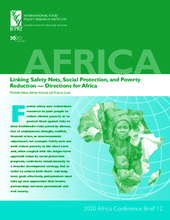The vast majority of poor people in Africa have no access to formal social protection mechanisms and formal safety nets. Formal safety nets redistribute resources to poor people to reduce chronic poverty or to protect them against risks posed by disease, loss of employment, drought, conflict, financial crises, or macroeconomic adjustment. Safety nets can both reduce poverty in the short term and, when coupled with the longer-term approach taken by social protection programs, contribute simultaneously to a broader development strategy.
In Africa and elsewhere, safety nets were promoted in the 1980s as a response to the adverse effects of structural adjustment. Though some safety nets had a developmental component, safety nets are still largely associated with the idea of a short-term buffer. “Social protection” is a newer term that incorporates safety net programs but also includes a role for renewed state involvement, emphasizes a longer-term developmental approach, includes social assistance and social insurance, and is often advocated as a right rather than a reactive form of relief. Social protection policy addresses not only programs aimed at reducing the impact of shocks and coping with their aftermath, but also interventions designed to prevent shocks and destitution in the first place.
Country-specific conditions dictate the choice and design of safety nets. Poor countries are unlikely to be able to afford and operate multiple programs, and must carefully select from among alternatives, finding those most appropriate to their conditions. This six-page paper discusses the advantages and disadvantages of several safety net program options relative to achieving both short- and long-term development goals. It also discusses contextual considerations useful to the effective design of these safety net programs.
©International Food Policy Research Institute

